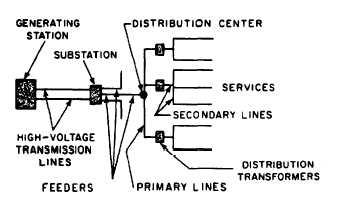CHAPTER 9
ELECTRICAL SYSTEMS AND PLAN
It is important for an EA working on a set of
drawings or plans to convey his ideas (or
instructions) effectively to a skilled craftsman
(CE) who is to install the electrical system. It is
also equally important for you, as an EA, to
understand and be thoroughly familiar with the
methods and basic functions associated with the
different materials and fixtures used in the
installation of an electrical system.
This chapter, when used in conjunction with
the previous chapters on wood, concrete and
masonry, and mechanical systems and plan, will
enable you to prepare construction drawings
(discussed in the next chapter), revise as-built
drawings in the field, and incorporate minor
design changes with ease.
ELECTRICAL SYSTEM
Each building requires an electrical system to
provide power for the lights and to run various
appliances and equipment. At Navy bases, the
electrical (or power) system consists of three main
parts: the power plant that supplies the electrical
power, the electrical distribution system (external)
that carries the electrical current from the
generating station to the various buildings,
and the interior electrical wiring system that
illuminates the building and feeds the interior
electrical power to the appliances and equipment
within the building.
In this section, we will discuss only the
external power distribution and the various
materials and fittings used in the installation of
an electrical system. For more information, refer
to the latest edition of Construction Electrician
3 & 2, NAVEDTRA 10636, National Electrical
Code® (NEC®), and Army Technical Manuals
(TMs).
ELECTRICAL (POWER)
DISTRIBUTION SYSTEM
Electrical distribution is defined as the delivery
of power to building premises, on poles or placed
underground, from the power plant or substation
through feeders and mains.
The power system is generally considered to
be a combination of two sections: the transmission
and the distribution. The difference between the
two sections depends on the function of each at
that particular time.
At times, in a small power system, the
difference tends to disappear, and the trans-
mission section merges with the distribution
section. The delivery network, as a whole, is
referred to as the distribution section and is
normally used to designate the outside lines and
frequently continues inside the building to include
power outlets.
Most land-based power systems use alternating
current (ac) rather than direct current (dc),
principally because transformers can be used
only with ac. An ac distribution system usually
contains one or more generators (technically
known as ALTERNATORS in an ac system); a
wiring system of FEEDERS, which carry the
generated power to a distribution center; and the
DISTRIBUTION CENTER, which distributes the
power to wiring systems called PRIMARY
MAINS and SECONDARY MAINS. A repre-
sentative transmission and distribution system is
shown in figure 9-1.
Figure 9-1.-Electrical transmission and distribution system.
9-1



